How to Clean Binoculars & Their Lenses

How do I clean my binoculars?
This question along with others like how to clean the lens on my binoculars, or what products should I use to take marks off the rubber armor on the exterior are ones that I get often because no matter how carefully you treat them, at some point you will need to clean your binoculars and it’s lenses.
So what is the best way to clean your binoculars, what should you avoid doing and what lens cleaning products should you get? In this guide to cleaning binoculars, I will answer these, give some advice and go through the steps that I take when cleaning my binoculars, scopes and my cameras:
My Advice on Cleaning Binoculars
Before you Start
The very first thing you should do is read the owners manual. I know that many of them are very basic, but some do point out specific ways in which the manufacturer recommends that you clean the specific product that you own. They also sometimes contain information on which products or chemicals to avoid which could potentially damage some of the materials that make up your device and so it is always worth checking first.
Many of the special coatings that are applied by the manufacturers to aid with light transmission can be relatively easy to scratch or damage, so be extra careful when cleaning lenses.
How to Clean a Lens – Without a Lens Kit
Step 1
The most important thing to keep in mind when lens cleaning is that the less rubbing you can do on any optical surface the better this holds true for the lenses on your binoculars, a scope or even your camera. Even the very best microfiber cloths can potentially damage the surface, probably not with the cloth itself, but if there is any dust or other small, but hard particles on the surface of either the lens or the cloth, they will act like sandpaper which can do real and permanent damage.
So because of this, it is vitally important that you remove any small particles from the lens first.
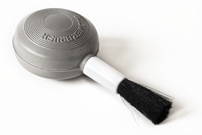 To do this, start by blowing off any large debris and dust from the body of the binoculars as well as on the lenses. You can do this with your breath, but because of the increased moisture, this can actually prevent some debris from flying off the glass, so it is far better to use a lens blower if you have one. You can get blower brushes specifically designed for camera and binocular lens cleaning, which you squeeze that work best.
To do this, start by blowing off any large debris and dust from the body of the binoculars as well as on the lenses. You can do this with your breath, but because of the increased moisture, this can actually prevent some debris from flying off the glass, so it is far better to use a lens blower if you have one. You can get blower brushes specifically designed for camera and binocular lens cleaning, which you squeeze that work best.
Some people advise using canned/compressed air cleaners that are often used for computers, but I personally would not as they can contain petroleum distillates, that could damage the coatings on your lenses.
If you don’t have access to a lens blower, using a brush with very fine hairs is your next best option for the first step. This will remove any fine particles from the lens surface with a minimum amount of pressure and thus minimize the chances of you scratching or marking the coatings.
Step 2
Then depending on how dirty or if there is still some dirt on your lenses you may wish to either lightly brush the lenses with a fine haired brush and/or carefully rinse with tepid water to remove any more stubborn abrasive particles, as well things like salt spray.
Important: Do not use household glass or even eyeglass cleaning solutions as they can damage the special coatings used on binocular lenses.
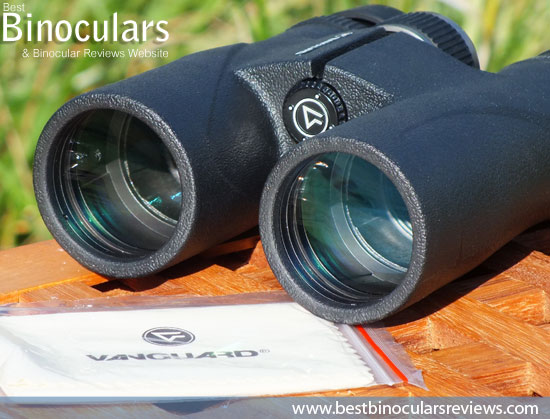
Step 3
First check that your lenses are not already clean as these next steps should only be carried out if the first two have still not managed to remove all dirt or markings.
Use a soft lent-free cloth or even better a high quality microfiber cloth to very gently rub the lenses, the best of which are designed specifically for the use on binoculars or cameras and are often called camera lens cloths.
Most new binoculars these days like the Vanguard Spirit ED 10x42 Binoculars in the image above will come with one in the box, but these do vary in quality but in general better binoculars usually come with better quality accessories. If yours is of poor quality, use it for cleaning the body (see below) and then get a better one for your lenses, which can bought fairly cheaply on the web (see links to cleaning kits below).
Make sure that your cloth is very clean and when not in use, store it somewhere were it will not collect dust and other debris. Notice how in the image above I keep mine in a sealed plastic bag, that way it remains completely clean until I need it.
How to Clean Lenses with a Cleaning Kit
If you asked me how to clean my lenses a year ago, I would have only given you the method above, which works fine, as long as you are careful and use a high quality cloth. However I have recently changed the way I personally clean my lenses on all my binoculars, scopes and cameras because a while back I was given some sample Carson C6 Lens cleaners to review and I liked them so much, I have continued to use them ever since.
You can also obviously get many other specialized lens cleaning kits, pens, brushes and cleaners for the exterior glass (see links below). I have used a few and in my experience they all work very well and really help you to remove all oily substances, markings and debris from your lenses whilst ensuring that you don’t damage them in any way.
I personally like using the Carson C6 CS-10 Lens Cleaner because unlike the rest, they use a dry-cleaning compound without any alcohol to help ensure that your delicate lens coatings are not damaged, yet they still easily wipe away any marks and oils from the lens surface.
So to demonstrate how I now clean my lenses, I am going to be using this Carson Lens Cleaner and a pair of Vanguard 10x42 Spirit ED Binoculars that really needed cleaning after spending a lot of time with e out in the field as you can clearly see from the main image at the top of the page. I will also describe the simple method used with more standard liquid based cleaning kits as well.
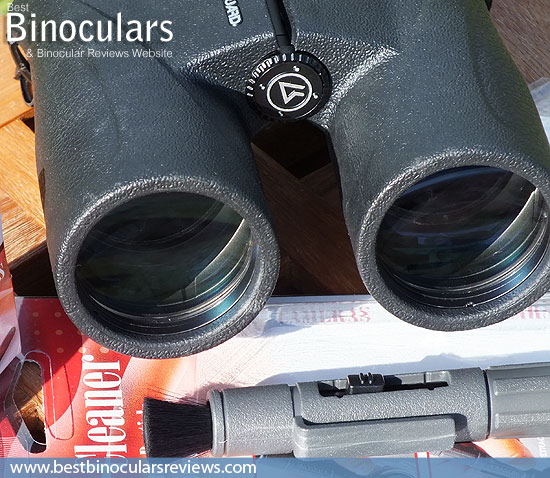
Step 1
As with the first method and even though these cleaners are designed for binocular lenses it is still important to keep the amount of rubbing on the lenses of your binoculars as light as possible and to a minimum.
So once again you can start by using a blower to remove any dust and other debris from the lens if you have one, but I have found that a lightly brushing the surface with the lens brush that comes with most kits (or can be bought separately) works just as well with a minimum amount of friction to minimize any chance of scratching. As you can see from the already much cleaner lenses on the bins in the image above.
Lens brushes are perhaps not as kind to the lenses as a blower, but they can remove slightly more stubborn dust and other particles and are far easier to store in your carry bag meaning that you will always have it with you when out in the field.
Remember to retract the brush into the pen as soon as you are finished to help keep it as clean as possible for as long as possible.
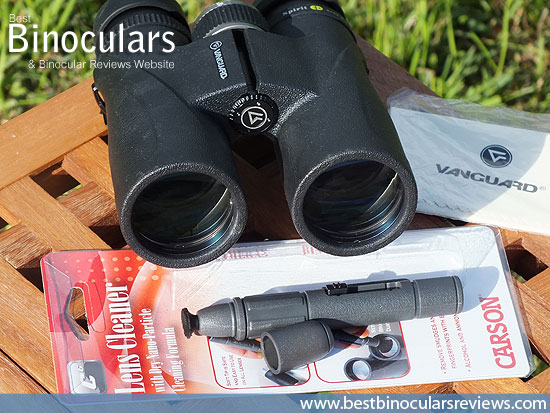
Step 2
Using the Carson cleaner, you just twist the end of the pen at the opposite end of the brush which “replenishes the dry cleaning compound” and then remove the cap which reveals the cleaning tip which you use to gently wipe the lens in a circular motion. This usually quickly and very easily removes all the smudges without having to apply much pressure at all.
If there are any oily marks left, all you do then is breathe lightly on the lens and wipe again with the cleaning tip.
That’s it and as you can see from the image above, what a few minutes before were really quite grubby lenses full oily smudges are now completely clean and as good as new.
If you are have one of the other liquid based cleaning kits, you would just apply a small amount (usually just a drop) of the supplied cleaning fluid on a clean piece of supplied lens cleaning tissue, or cotton-tipped applicators. With some kits you will spray the cleaning fluid onto the lens or just used supplied wet wipes. Then Gently wipe the lens surface from the edges toward the center of the lens, with a lifting rather than rubbing action.
Sometimes you can get away with just using the micro-fiber cleaning cloth instead of the lens tissue, which depending on how dirty the lens is, may not requires the lens cleaning fluid.
Lens Cleaning Kits & Pens
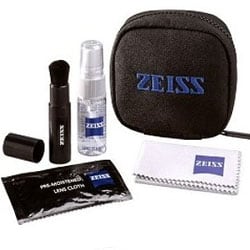 You can easily find many lens cleaning kits and “pens” on the web that are often designed to be used with cameras, but work just as well with your binoculars or scopes. But keep an eye out as there are also a few that are specifically designed for binoculars, including kits made by Zeiss and Swarovski.
You can easily find many lens cleaning kits and “pens” on the web that are often designed to be used with cameras, but work just as well with your binoculars or scopes. But keep an eye out as there are also a few that are specifically designed for binoculars, including kits made by Zeiss and Swarovski.
Video Demonstration
Also take a quick look at this video below. Produced by Swarovski Optik, it goes over how to quickly clean your lenses out in the field using their brush and single use moist cleaning wipe:
Nikon also make an excellent lens pen cleaning system, that is small making it simple to carry on your person or binocular case and consists of a soft brush that retracts into pen body to stay clean. The brush can safely remove fingerprints, dust, and other debris from your binoculars and works with all types of binoculars, telescopes, cameras and other optical products.
For full kits, take a look at my Guide to Optic Lens Cleaning Kits
US Shoppers
UK Shoppers
How to Clean Binoculars – The Body
When people ask "How to clean my binoculars?" they are usually referring to the lenses, however it is important to also clean the body correctly. Use the wrong solution and you could end up damaging the rubber coating:
Step 1
Like the lenses, first blow over the whole body of the binocular using a blower to remove any tiny sand and grit particles which could act as sandpaper when you use the more vigorous techniques in the following steps.
Step 2
Using a dry lent-free cloth (or microfiber cloth), gently wipe off all parts of the binocular including the barrels, focusing mechanism and the eyepieces. You mist be very careful not to touch or wipe any of the lenses. A good tip is to hold the binoculars upside down so that any dirt falls away from the lens surfaces.
Step 3
If you still have marks or dirt on the outer metal, rubber, or plastic of the body, you can use a soft cloth with warm water and possibly a mild cleaner, but be very careful and make sure you don’t use this on the lenses.
Cleaning the inside your Binoculars
What if there is moisture, dust or dirt inside binoculars, how do I take my binoculars apart to clean them?
Don’t! Remember many new binoculars, especially the more expensive pairs are filled with nitrogen that keep the optics from fogging up, which will be lost if you open them.
Opening up your binoculars will also probably destroy any waterproof seals and you could also easily make them completely unusable by moving the alignment of the lenses or prism.
If you think the inside of your binoculars needs to be cleaned, it is best to contact the manufacturer or an authorized dealer for more information take a look at my page on Binocular Repairs that includes contact details for most of the major manufacturers as well as independent experts that can repair your optics.

 Article | Posted by Best Binocular Reviews
Article | Posted by Best Binocular Reviews 
 Categories:
Categories:  Tags:
Tags: 
